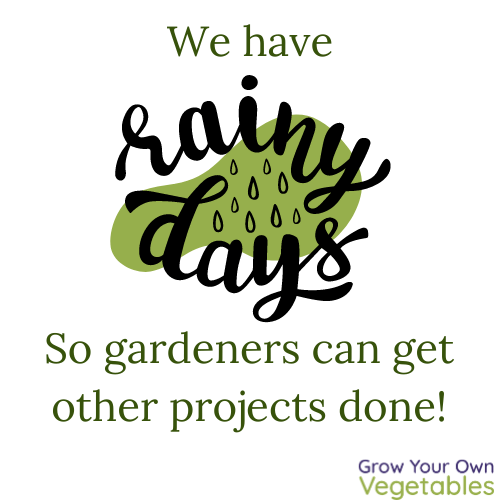Home Gardener’s
Weekly
Issue
No. 143
October
03, 2025
🧑🍳 Ready to feel energized in the kitchen?
The Plant-Based Beginner’s Bootcamp kicks off Monday, October 6th, and you’re invited to join—completely free! Hosted by Kim Murphy of Simply Plant-Based Kitchen, this fun 5-day challenge will show you how easy (and delicious!) a whole food, plant-based lifestyle can be.
Here’s what you’ll discover inside the challenge:
🍲 Daily cooking demos with simple, flavorful plant-based recipes
🍎 Which foods to enjoy—and which to skip
🥕 How to build a strong foundation with whole foods backed by science
You’ll also get access to a private community where you can connect with others, ask questions, share tips, and even complete daily challenges for a chance to win prizes.
This challenge is all about small, simple steps toward a plant-based lifestyle—no pressure, just tasty, practical ideas to boost your energy and confidence in the kitchen. Whether you’re brand-new or looking for fresh inspiration, this is for you!

Weekly Garden Tip
A lot of people who are new to growing food first find themselves wondering where to start. Did you know that the moment a food is harvested it begins to lose nutrients?
Basically, that means that the majority of the people are eating half-dead food. The exponentially damaging result here is that we’re having to consume 2-6 times the same amount of food for the nutrition we could have by just growing our own. This is really taxing on the body because the digestive system has to work doubly hard. So, one of the best ways to start gardening is to pick the three foods you eat the most, and grow those first!

Free Resource
🌱 Grow Your Own Microgreens—Fast and Easy!
Discover the joy of fresh, flavorful microgreens with our free “6 Easy-to-Grow Delicious Microgreens” Guide. Whether you’re a seasoned gardener or just starting out, this quick guide gives you everything you need to grow nutrient-packed microgreens year-round—right in your kitchen!
Inside, you’ll learn:
🌱 How to get a plate full of microgreens in as little as 10 days
💧 The simple watering techniques that make all the difference
🥗 Ways to add fresh, delicious flavors to your salads
✅ How to ensure your microgreens are safe to eat
💰 Tips to save money on seeds
⏱ When to harvest for maximum flavor and nutrition
🌱 Grow Your Own Microgreens—Fast, Fresh, and Delicious!
What if you could harvest nutrient-packed microgreens in just 2–3 weeks… right from your kitchen counter? Say goodbye to bland, spoiled greens and hello to fresh, flavorful microgreens anytime you want.
The Grow Microgreens Micro Course is a step-by-step guide designed to help you grow your own vibrant microgreens—indoors or out—even if you don’t have a garden. For only $47, you’ll get the course plus bonuses to make growing simple, fun, and repeatable.
Get started today growing and harvesting
a continuous supply of nutrient rich greens FAST!
Here’s a quick sample of what you learn in this course:
🌱 Growing microgreens ALL YEAR ROUND in a small space
🌱 Growing delicious microgreens indoors or out
🌱 Buying high-quality organic seeds at affordable prices
🌱 Planting a wide variety of easy-to-grow microgreens
🌱 Germinating to grow strong and healthy microgreens
🌱 Watering your microgreens effectively and efficiently
🌱 Lighting cost-effectively to avoid seedling stretching
🌱 Troubleshooting the most common problems
🌱 Budgeting with a done-for-you template
🌱 Harvesting your microgreens to prolong shelf life
🌱 Storing your microgreens properly for food safety
🌱 Growing your greens even easier with tips and tricks
Microgreens do not require a greenhouse or lots of equipment. To get started, you only need some trays, lights, soil, seeds, and water.
They also do not require a lot of time. Typically, you can start harvesting within 2-3 weeks of planting your seeds. When you plant on a regular schedule, you have an abundant supply of fresh, healthy microgreens all year round.

🍅 BLOG 🍅
How to Grow Your Own Vegetables & Save Money
Rising grocery bills don’t have to mean sacrificing fresh, healthy food. Growing your own vegetables is not only rewarding—it can save you hundreds of dollars a year! In our latest blog, we share tips for every gardener: how to start seeds for maximum savings, creative ways to grow even in small spaces, and smart methods to preserve your harvest so you can enjoy it year-round. Whether you’re just starting out or looking to fine-tune your garden, these strategies help you grow more, waste less, and put money back in your pocket.
Microgreens aren’t just a garnish—they’re a burst of flavor and nutrition that can transform any dish.
In this week’s recipe spotlight, discover creative ways to use fresh microgreens in charcuterie boards, soups, and even a refreshing melon salad.
These tiny greens pack a big taste while adding vibrant color to your meals.
👁️ Naturally Restore and Protect Your Vision
Blurry vision, floaters, or age-related eye changes aren’t just “normal”—they can signal deeper health issues, including risks to your heart, brain, and circulation. Your eyes are a window to your overall health, and what you eat plays a huge role in keeping them strong.
Join Jonathan Landsman for the Eye Health Docu-Class, a free program that reveals the most overlooked causes of vision loss and eye disease—and shows how natural, food-based strategies can help restore and protect your eyesight. Learn from top holistic eye experts how simple, fresh-food habits can support your vision and overall health.
🌿 Did you know some herbs can help protect your eyesight? If your eyes feel tired, dry, or irritated after long hours on screens, herbal remedies may offer gentle relief.
Our friend Jonathan Landsman, a natural health expert with nearly 40 years of experience, created a free Herbal Eye Care Guide. It’s packed with at-home remedies using herbs to soothe dryness, reduce irritation, and relieve eye strain—plus tips to naturally support your vision.
When you grab the guide, you’ll also get complimentary access to the Eye Health Docu-Class, featuring top holistic eye doctors who share strategies to prevent—and even reverse—common vision problems.
What: Plant-Based Beginner’s Bootcamp
Who: Kim Murphy, Simply Plant Based Kitchen
When: Oct 6-10, 2025
Join this fun, 5-day challenge to show you how easy and delicious a whole food plant-based lifestyle can be. You’ll learn how to:
• Build a strong foundation with whole foods backed by science
• Know which foods to enjoy—and which to skip
• Cook simple, flavorful plant-based meals in daily cooking demos
This challenge is all about small, simple steps toward a plant-based lifestyle. No pressure—just fun, tasty, and practical ways to feel energized and confident in the kitchen.

WHAT’S HAPPENING IN HARVEST CLUB
🗓️ Mark your calendar: Our next Garden Jam is Monday, October 13! Connect with fellow gardeners, ask questions, and share tips as we explore fresh ways to grow, preserve, and enjoy your garden bounty. Whether you’re tackling composting, planning your next crop, or experimenting with new recipes, we’re here to support your garden journey and celebrate growing together as a community.
Missed the last session? 🌿 View the replay in your portal here.
🍅🥕🌽🫐🍆🌱 Keep moving forward on your fresh food goals—ask questions, share successes, and get inspired in Harvest Club! 🍅🥕🌽🫐🍆🌱
Not a member of our garden membership Harvest Club? You can get a one-time complimentary two-month membership with any of our courses. Harvest Club has tons of resources to help you thrive. Plus, you get access to ongoing garden support through email. Learn more here.

Dear Arti:
Question: I have only 1 raised bed, pretty small. I want to raise foods all year long– indoors, too– fruits and veggies. – Macela Carmo dos Santos, NY
Answer: Hi Macela.
That’s great! Now, for fruits you generally need more space. But you can grow a lot of vegetables and herbs in one raised bed! It’s all about knowing when to plant what and how to maximize your space. For this, you’ll need to create a crop plan. To get you started, download this guide. It gives you 6 tips to Maximize Your Garden Space.
Happy Gardening!


🍅 One of the favorite ways for GYOV CEO and Lifestyle Gardener Denise Beins to enjoy her bountiful tomato harvest is making lacto-fermented tomato sauce.
It’s simple to make, packed with probiotics, and such a tasty way to savor the harvest long after tomato season has passed.
Grab the recipe in this guide and enjoy your own tomatoes in a whole new way!


Connect with us:
This page may contain affiliate links. If you click and take action, Grow Your Own Vegetables LLC may be compensated. We only recommend events and products that we love and that we know can be helpful to you as a gardener.








